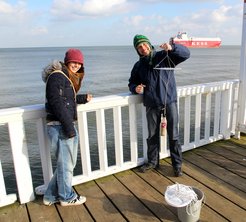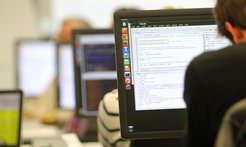Testing the waters
The first ever international Ocean Sampling Day will be held on June 21, when scientists plan to carry out a “health check” of our oceans by investigating its microbial communities.
Whether seawater appears clear, blue, green or brown, it is teeming with life. Every millilitre of seawater contains around one million microorganisms - and their importance for the climate and environment is still not fully understood. Since its founding in 1992, the Max Planck Institute for Marine Microbiology has been focussing on these microscopic denizens of the seas. On 21 June it is set to raise ocean research to a new level together with a team of scientists from around the world.

Ocean Sampling Day is a unique day on which, for the first time, scientists at over 160 marine stations around the globe will simultaneously collect, filter and analyse water samples. This will generate a huge set of data, for example on temperatures, wind speed, salinity and, above all, molecular biological data that can be compared, sorted and linked [Fig. 1]. Initially, all the data will be stored; they will then be analysed over the coming years by various methods. The planned date, 21 June, was by no means chosen randomly: the summer solstice marks the longest day of the year in the Northern Hemisphere: marine organisms – at least those in the upper strata – thereby enjoy the longest exposure to the sun and are very active.

However, it is not necessary to be an official marine researcher to participate in Ocean Sampling Day. On the contrary: the OSD team is inviting all interested hobby researchers to take samples from rivers, lakes and coastal waters. The procedure is explained in a short video tutorial and the data, for example the temperatures and salinity, can then be easily uploaded in the field via the OSD Citizen App. In fact, a photo of one’s own amateur research group can even be added. Using commercially available aquarium equipment, it is possible, but not mandatory, to measure all the parameters and enter them into the app. “You can measure as much or as little as you want. We welcome any contribution, even samples from rain barrels - but then definitely with a photo!” says Anna Klindworth of the OSD Core Team with a smile [Fig. 2]. Although it all sounds like fun, in the end all the data will be compared and linked to those collected by the researchers. “Of course, the rain barrels won’t exactly fit into the picture, but they’ll serve as outliers in any case.”

Ocean Sampling Day is not just about international molecular biologists, computer scientists and engineers working together. It is also about the general public being able to actively take part in research as “citizen scientists”, and show their enthusiasm for environmental matters. After all, the OSD topics are also of political interest: international cooperation between marine researchers needs to be strengthened, particularly in the Mediterranean region, and coordinator Frank Oliver Glöckner (link to interview) will sign a charter to this effect with science representatives in Monaco on 21 June.
All those who have no body of water nearby can still be there live to witness the sampling on the Azores. A report on Ocean Sampling Day will also appear in the 21 August issue of the science magazine X:enius.


